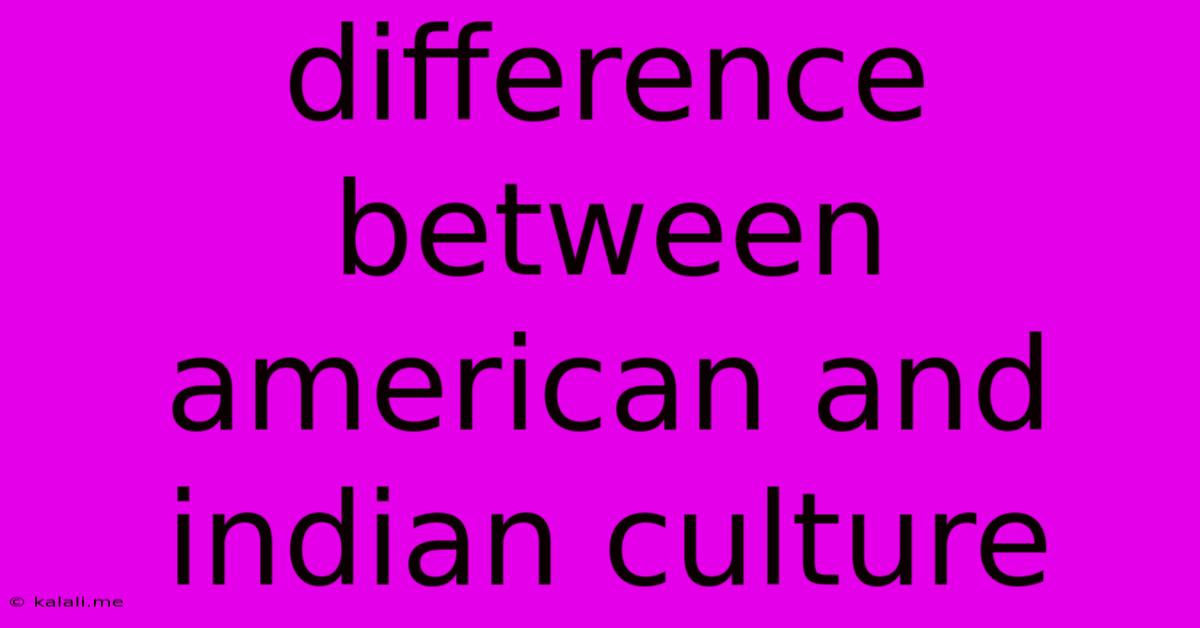Difference Between American And Indian Culture
Kalali
Jun 15, 2025 · 3 min read

Table of Contents
Decoding the Differences: A Deep Dive into American and Indian Culture
Understanding the nuances of cultural differences is crucial in today's globalized world. This article explores the significant contrasts between American and Indian cultures, focusing on key aspects like individualism vs. collectivism, family structures, communication styles, and religious beliefs. Navigating these differences fosters better cross-cultural understanding and appreciation.
The vast differences between American and Indian cultures stem from their unique histories, geographies, and societal evolutions. While generalizations can oversimplify complex realities, examining key distinctions provides valuable insights.
Individualism vs. Collectivism: A Fundamental Divide
One of the most striking differences lies in the core values: individualism is deeply ingrained in American culture, while collectivism dominates Indian society. In America, personal achievement, independence, and self-reliance are highly valued. Individuals are encouraged to pursue their own goals and ambitions, prioritizing personal needs above collective ones. This translates into a competitive work environment and a focus on personal branding.
Conversely, Indian culture emphasizes the importance of family, community, and group harmony. Collective well-being takes precedence over individual desires, and decisions are often made considering their impact on the extended family or community. Loyalty and responsibility to the family are paramount, and individual aspirations are often aligned with the family's goals.
Family Structures and Dynamics: A Tale of Two Worlds
Family structures also exhibit stark contrasts. The American nuclear family—parents and children—is prevalent, with individuals often moving out of their parents' homes to establish independent households. While extended family ties exist, they are generally less intertwined in daily life compared to Indian families.
Indian families, on the other hand, typically involve extended family members living together or in close proximity. Grandparents, uncles, aunts, and cousins play significant roles in raising children and supporting family members. Family loyalty and obligation are deeply rooted, and decisions are often made collaboratively, considering the needs and opinions of all family members. This strong familial bond provides a sense of security and belonging but can also lead to limitations on individual autonomy.
Communication Styles: Direct vs. Indirect
Communication styles differ significantly. Americans tend to favor direct and explicit communication. They value clarity and efficiency, and expressing opinions openly and honestly is considered normal. Indirect or ambiguous communication can be perceived as evasive or untrustworthy.
Indians, conversely, often utilize indirect and implicit communication. Maintaining harmony and avoiding conflict are prioritized, leading to a more nuanced and subtle approach to conversation. Openly criticizing or disagreeing might be considered impolite or confrontational. Understanding the subtle cues and unspoken messages is crucial in navigating Indian communication.
Religious and Spiritual Beliefs: A Tapestry of Faith
Religious and spiritual beliefs form another key differentiator. While the US is a diverse nation with a variety of religious affiliations, it has a predominantly secular outlook. Religious beliefs are often considered personal matters, and religious observance varies widely.
India, on the other hand, is deeply rooted in spirituality and religion. Hinduism, Islam, Sikhism, Buddhism, Jainism, and Christianity coexist, shaping various aspects of social life and influencing customs, traditions, and values. Religious festivals and practices are deeply ingrained in the culture, and faith plays a significant role in many individuals' daily lives.
Conclusion: Bridging the Cultural Gap
Understanding these fundamental differences—individualism versus collectivism, family structures, communication styles, and religious beliefs—is essential for fostering productive relationships and meaningful cross-cultural interactions. While generalizations may not capture the entirety of such complex societies, acknowledging these core distinctions provides a valuable framework for navigating the fascinating differences between American and Indian cultures. Respect for cultural diversity and a willingness to learn and adapt are crucial for successful intercultural engagement in an increasingly interconnected world.
Latest Posts
Latest Posts
-
Who Arranged Elements By Atomic Number
Jun 15, 2025
-
Least Common Multiple Of 4 6 And 7
Jun 15, 2025
-
Which Statement About Speed And Or Velocity Is True
Jun 15, 2025
-
A Wave Having A Frequency Of 1000 Hertz Vibrates At
Jun 15, 2025
-
What Is The Difference In Email And Gmail
Jun 15, 2025
Related Post
Thank you for visiting our website which covers about Difference Between American And Indian Culture . We hope the information provided has been useful to you. Feel free to contact us if you have any questions or need further assistance. See you next time and don't miss to bookmark.